
Your home’s exterior is more than just its appearance, it is a system designed to protect everything inside. At the core of that system is siding, a key component that directly influences how well your home stands up to weather, temperature changes, and everyday wear.
While many homeowners think of siding as a purely aesthetic feature, its performance impacts energy efficiency, structural durability, and long-term maintenance costs.
In this article, we will break down what siding actually is, how it protects your home, the different material options available, signs that it may need replacement, and how to choose the best siding for long-term value and performance.
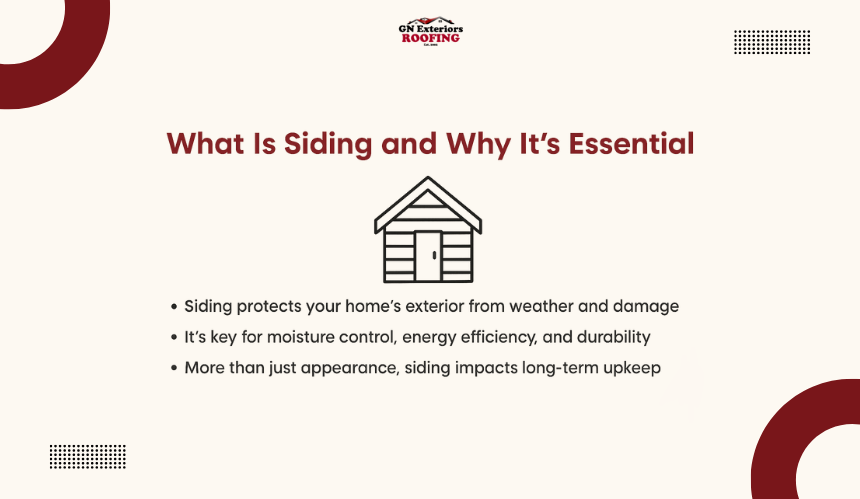
Siding, in construction terminology, refers to the exterior cladding material installed on a home’s outer walls to protect the structure from environmental exposure.
It functions as a critical part of the building envelope, forming a barrier that prevents water infiltration, regulates thermal performance, and shields the internal wall assembly from mechanical damage.
Unlike decorative features, siding is engineered to meet structural, thermal, and weather-resistance standards. It works in tandem with other components like house wrap, sheathing, and insulation to create a complete moisture and air management system.
Siding systems are available in a range of materials, including vinyl, Hardie plank, cedar impression siding, engineered wood, aluminum, and polymer composites. Each of them offers specific performance characteristics based on climate, budget, and desired lifespan.
In short, siding helps your home last longer. By deflecting moisture, blocking UV rays, and standing up to wind and impact, it protects the critical layers underneath, like insulation, sheathing, and framing. That means fewer repairs, less maintenance, and a stronger home overall.
Next, let’s look at the most common siding materials and what makes each one unique in terms of performance and protection.
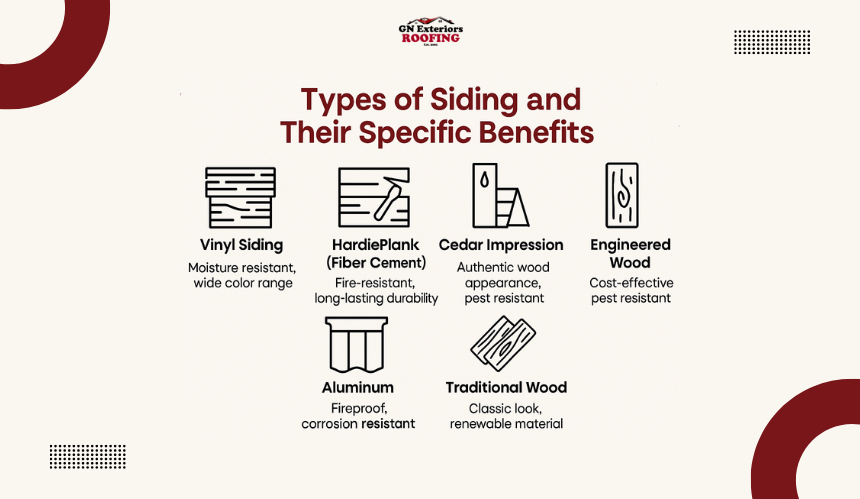
Vinyl siding is a cost-effective, low-maintenance option made from durable PVC. It resists moisture and insect damage, comes in many colors, and doesn’t require painting. This makes it a popular choice for homeowners looking for affordable protection with minimal upkeep.
Fiber cement siding combines cement, sand, and cellulose fibers to create a product that’s highly durable and fire-resistant (Class A rated). It resists rot and pests while mimicking the look of real wood, all with less maintenance. This siding is ideal for harsh weather zones and fire-prone areas.
Key benefits: Fire-resistant, long-lasting durability
Available as natural cedar or molded polymer, Cedar Impression siding delivers a realistic wood look. Natural cedar offers pest resistance and decay protection, while polymer versions provide the same aesthetic with even lower maintenance needs. This makes it a great choice for traditional-style homes.
Engineered wood offers the warmth and texture of real wood but at a lighter weight and lower cost. It is treated to resist moisture and insects, making it easier to maintain than natural wood. This option suits homeowners seeking a wood look with improved durability.
Key benefits: Cost-effective, pest resistant
Aluminum siding is fire-resistant and won’t rust, rot, or attract pests. Its reflective surface can help reduce cooling costs in hot climates. Lightweight yet strong, it fits well with modern home designs and coastal environments.
Natural wood siding provides unmatched beauty and customization options. While it requires regular painting or staining to protect against weather and pests, many homeowners appreciate its authentic appearance and eco-friendliness.
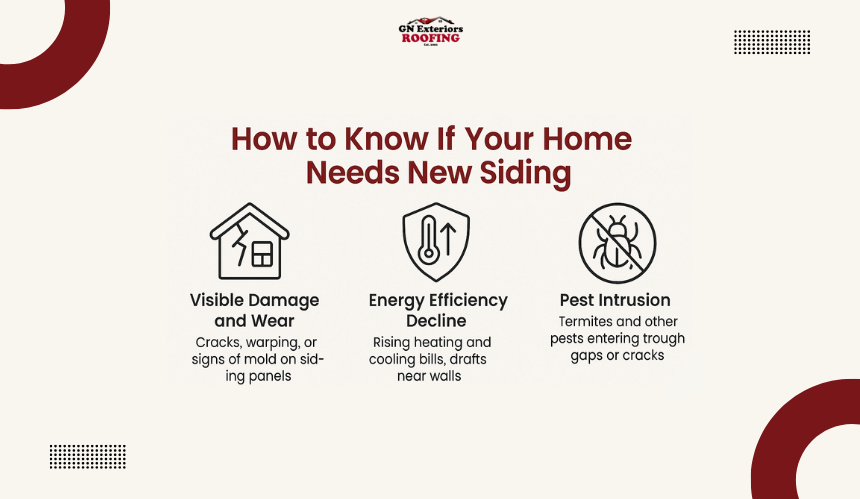
Most siding materials have a typical lifespan. For example, vinyl siding lasts about 20–40 years, HardiePlank (fiber cement) can last up to 50 years, and Cedar Impression siding ranges from 20–30 years for natural cedar to over 30 years for polymer versions. If your siding is aging, fading, or constantly needing repairs, full replacement is often the smarter long-term choice.
When in doubt, professional siding inspection services can accurately assess the condition and recommend whether repair or replacement is the best course of action.
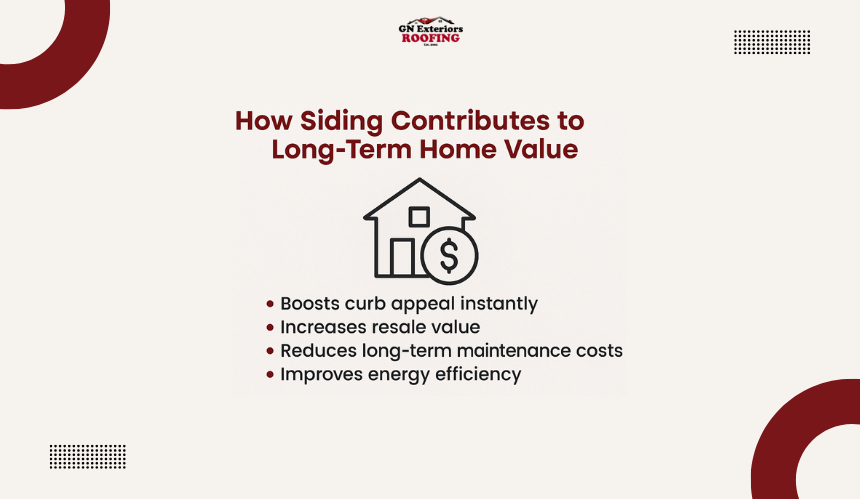
First impressions matter, and siding plays a major role in how your home looks from the street. New, clean, and well-chosen siding instantly improves visual appeal and makes your home more attractive to buyers.
High-end options like Cedar Impression or fiber cement siding can mimic premium materials without the high maintenance, giving your home a refined, updated appearance.
According to national cost vs. value reports, siding replacement consistently ranks among the top remodeling projects in terms of return on investment.
On average, replacing siding can recoup 70–80% of the project cost during resale. Homes with new siding are often appraised higher and sell faster, especially when the exterior shows no signs of wear or weather damage.
For example, if you spend $10,000 replacing your home’s siding, you can expect to increase the home’s resale value by about $7,000 to $8,000 on average.
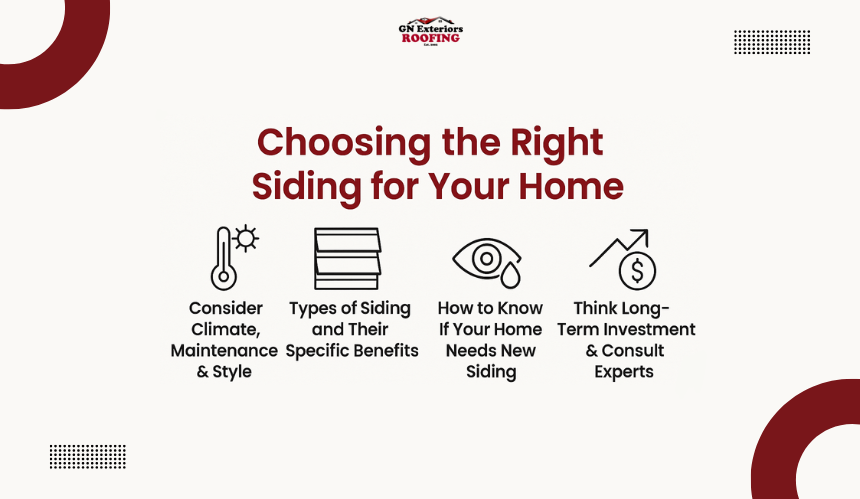
Selecting the right siding is about matching material performance to your home’s climate, architectural style, and maintenance expectations. With so many options available, the best choice often comes down to a balance of durability, efficiency, and long-term cost.
Below are four things you must consider before choosing the type of siding for your home.
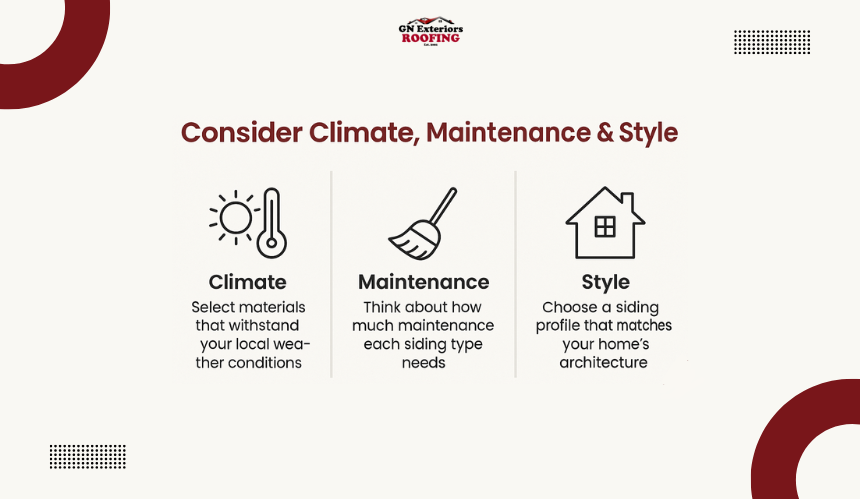
In areas with extreme cold, high humidity, or strong winds, siding needs to do more than just cover your walls, it must perform. For example:
Think about how much time you’re willing to spend on upkeep.
Siding has a big visual impact. Horizontal lap siding suits traditional and colonial-style homes, while board-and-batten or shake textures enhance craftsman or coastal homes.
Choosing a profile that complements your roofline, windows, and overall structure brings everything together.
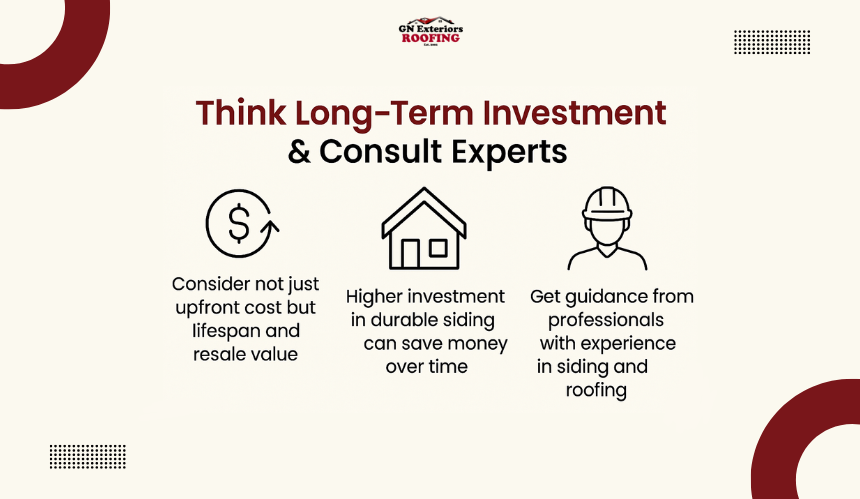
Some materials may cost more upfront but pay off in the long run. Fiber cement, for instance, may have a higher initial cost than vinyl but often lasts longer and provides better protection. Consider not just material costs, but lifespan, energy efficiency, and resale value.
Not sure which siding is right for your home? At GN Exteriors, we help homeowners make informed decisions that protect their property and boost long-term value. Whether you’re upgrading your siding, repairing your roof, or replacing old gutters, our team is here to guide you through every step.
Insulated vinyl includes a rigid foam backing that boosts thermal performance, reduces air leakage, and stabilizes the panels. It typically results in noticeable energy savings and a sturdier feel compared to standard vinyl.
Yes. Most siding types fade with sun exposure over time, but the rate depends on material and quality. High-grade vinyl and fiber cement (like James Hardie) fade very slowly, while cheaper options may show noticeable discoloration sooner.
You can repaint vinyl to freshen its look, provided you choose the right low-heat acrylic paint and follow prep guidelines. It is usually a temporary cosmetic fix, not a long-term solution.
Painting won’t restore performance issues like warping, cracking, or aging insulation. Plus, it often voids the manufacturer’s warranty and requires reapplication within a few years. If the siding is structurally failing or over 20 years old, replacement is usually the smarter investment.